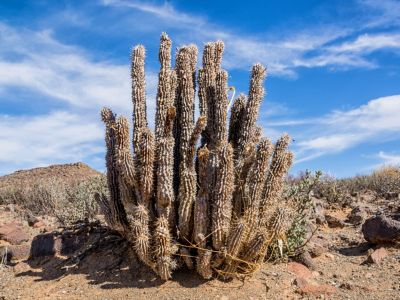What is Hoodia?
Picture a low-growing plant with plump, spiny limbs and an attractive flower that smells like rotting flesh. It probably doesn’t represent a plant you want in your home, but this African native succulent has been a staple of the indigenous people’s diet and may signify some hope for those challenged with obesity. Hoodia has been on the menu for thousands of years in South Africa and may soon be coming to a store near you. What is hoodia? There are over 20 species in the genus with Hoodia gordonii plant just one of the many amazing specimens. Tired of hearing your tummy grumble all the time? Hoodia is a possible answer. The plant is covered in spines and has thick, fleshy limbs. It is a low-growing plant that will only get 23 inches (58.4 cm.) in height at maturity. The spines and the short stature are necessary adaptations to protect the plant from hot scorching sun and conserve moisture. The spines also prevent many animals from eating the flesh. Hoodia produces a flat, saucer-shaped flower that is flesh colored. The flower is quite interesting looking but keep your distance if you get to see a bloom. The flower smells like something gone bad, but the odor attracts flies which pollinate the plant.
Possible Benefits of Hoodia
The Federal Drug Administration has not approved the safety of using hoodia as an appetite suppressant but that hasn’t stopped several companies from manufacturing and distributing the supplement. The thick stems are edible, once you remove the spines, and appear to diminish appetite. Research done in the 1960’s on indigenous plants found that animals who ate the succulent lost weight. This didn’t immediately turn into a breakthrough discovery. It took several more decades before the pharmacological company, Phytopharm, took notice of the research and began to conduct their own. The result is a huge farming operation in South Africa with goals toward marketing the product in the future.
Hoodia Cultivation
Phytopharm has acres of farmland devoted to hoodia cultivation. The plant may be grown in native soil or in a standard potting mixture. Water is the key between life and death with this plant. It lives in the Kalahari where rainfall is minimal. Too much water can kill the plant but too little will have the same effect. The average watering rules are once every third month all year around. That is only 4 watering cycles per annum. The only other considerations are lighting, insects and disease. Farmers are just learning how to deal with any insect pests and disease in a cultivated setting. Hoodia gordonii plants require bright light but prefer not to be exposed to the highest sun of the day. Some protection from noon time heat is appreciated. Wide scale cultivation is still in the learning phases as the potential drug becomes a cash crop. Disclaimer: The contents of this article is for educational and gardening purposes only. Before using ANY herb or plant for medicinal purposes, please consult a physician or a medical herbalist for advice.
